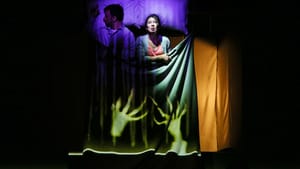Stay in the Loop
BSR publishes on a weekly schedule, with an email newsletter every Wednesday and Thursday morning. There’s no paywall, and subscribing is always free.
What nightmares may come
Annenberg Center Live presents Haruki Murakami's 'Sleep'

It’s hard to imagine anyone bettering the prose of Haruki Murakami, one of contemporary literature’s most distinctive stylists. In translating Murakami’s 1992 short story Sleep for the stage, the New York–based ensemble performance troupe Ripe Time doesn’t try; much of the script (adapted by Naomi Iizuka) comes directly from the source text.
Instead, director/deviser Rachel Dickstein and her athletic six-person company focus on drawing out the arresting, elliptical elements of Murakami’s writing through music, movement, and stage magic. Though occasionally arresting, the resulting performance — which premiered over the weekend at the Annenberg Center’s Harold Prince Theatre and will travel to New York as part of the New Wave Festival at Brooklyn Academy of Music (BAM) — often felt like a hollow exercise in stagecraft, an unnecessary retelling of a contained literary masterpiece better left alone.
Sleep concerns an unnamed woman (Jiehae Park) who hasn’t slept in 17 days. She informs us of her predicament in a tone blending anguish and ecstasy, suggesting a slipping grasp on reality. In her mind, however, she gains strength and acuity from her lack of repose. It has allowed her to see the hollowness of her life: her boring marriage to a banal dentist (Brad Culver, far too attractive for a character routinely described as ugly); her enigmatic son (adult actor Takemi Kitamura, convincingly childlike); her constantly stalling old Honda. The woman convinces herself that her sleeplessness holds the key to escaping her unfulfilled suburban existence.
Although the woman remains sleepless throughout the 75-minute play, her state of consciousness grows more and more dreamlike. It becomes impossible for her, or the audience, to know what realm she exists in. Is she experiencing waking hallucinations? Could she actually be dead?
Living the dream
To achieve this sense of disorientation, Murakami uses repetition flecked with minor variations — a common literary technique. Dickstein and Iizuka replicate this, but it loses much of its power in translation. Watching the same scene performed two or three times may make narrative sense, but it becomes grating in practice. For her part, Park’s largely affectless line readings do little to imbue a rising sense of tension as the scenes repeat.
Other production elements are justifiable but problematic. The set (by Susan Zeeman Rogers) consists mostly of a walled-in box placed at center stage. Park rarely leaves the box, which suggests her character’s confinement inside a tortured mind. But the rigidly constructed cube, surrounded by the negative space of the theater’s long, deep stage, caused visual impairments; from my seat in the fourth row, I often had to contort myself to see the full stage picture. Any moments played on the stage floor — and there were several — were entirely lost to me.
The significance of Anna Karenina, which the woman reads in her sleepless fugue, was not lost to me — but whereas Murakami spends entire paragraphs cleaving that fictional heroine’s marital unhappiness to his protagonist’s drab existence, her presence here feels shoehorned. Still, Paula McGonagle looked smashing in costume designer Ilona Somogyi’s rendering of Anna’s famous red ball gown.
Only the play’s constant musical underscoring — composed and performed live by NewBorn Trio — created something truly distinct and transcendent. Musicians Katie Down, Miguel Frasconi, and Jeffrey Lependorf produce soundscapes that truly unsettle the audience, communicating a greater sense of menace and disorientation than the complicated choreography they support. Perhaps Sleep might have been more successfully adapted as a chamber opera.
If you missed Sleep this weekend, I wouldn’t recommend rushing to book Amtrak tickets to catch its BAM run. (Performances are sold out anyway, according to BAM’s website). Stay in Philadelphia and read Murakami’s still-beguiling short story instead.
What, When, Where
Sleep. Adapted by Naomi Iizuka from a story by Haruki Murakami, Rachel Dickstein directed. Ripe Time. October 27-28, 2017, at the Annenberg Center for the Performing Arts’ Harold Prince Theatre, 3680 Walnut Street, Philadelphia. (215) 898-3900 or annenbergcenter.org.
November 29-December 2, 2017, at the BAM New Wave Festival, Brooklyn Academy of Music's Fisher Theater, 321 Ashton Place, Brooklyn, New York. (718) 636-4100 or bam.org.
Sign up for our newsletter
All of the week's new articles, all in one place. Sign up for the free weekly BSR newsletters, and don't miss a conversation.

 Cameron Kelsall
Cameron Kelsall